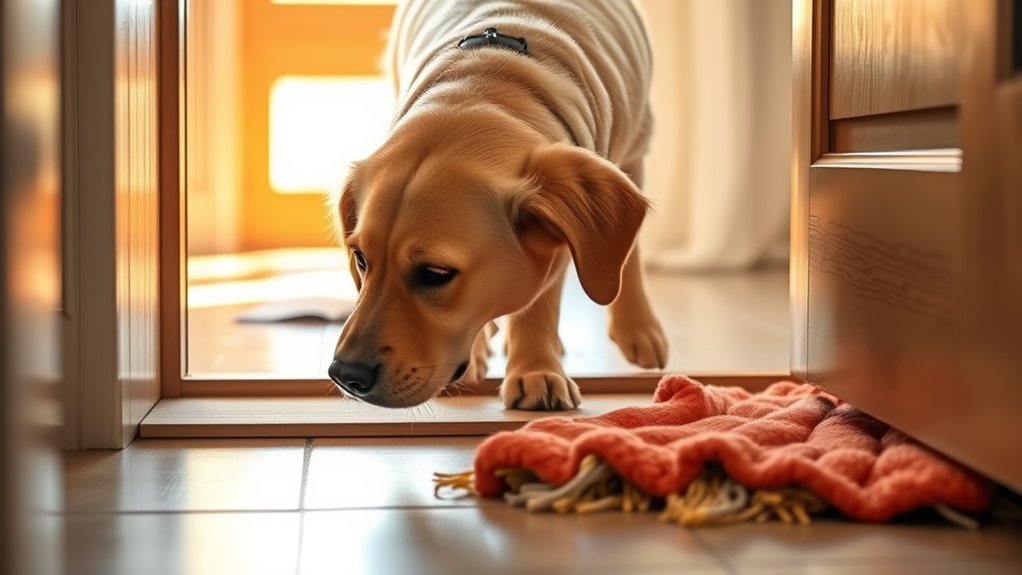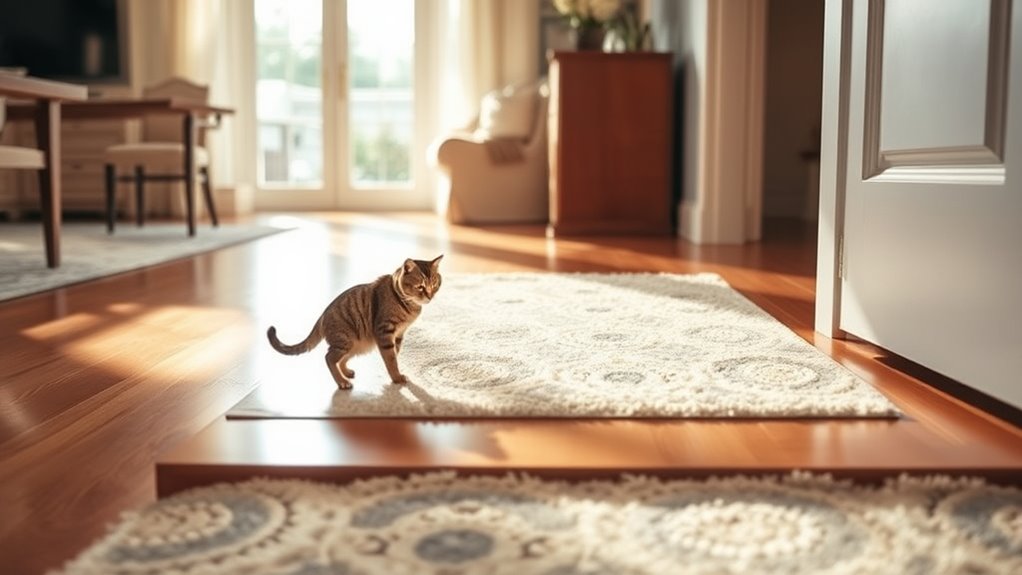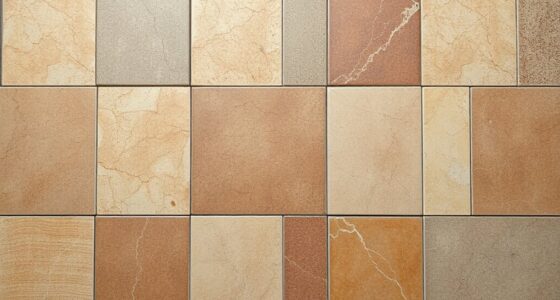To create thresholds that truly work for your pets, focus on designs that are easy to cross for all sizes and mobility levels. Choose low-profile, sturdy, and slip-resistant materials like rubber or textured surfaces that suit active or elderly pets. Proper installation and level fitting prevent gaps and hazards, while customizing with ramps or slopes helps pets with arthritis. Careful attention to these details ensures safe, comfortable crossings—keep going to discover how to make your pet’s progressions even better.
Key Takeaways
- Ensure thresholds are level and properly fitted to prevent gaps, trips, and drafts.
- Choose durable, non-slip materials like rubber or textured surfaces for safety.
- Design thresholds with low profiles or ramps for easy crossing by pets of all sizes.
- Securely install thresholds using appropriate fasteners to maintain stability and environmental control.
- Tailor thresholds to pet needs, considering mobility issues, weather resistance, and ease of maintenance.

Thresholds in pet homes play a essential role in shaping your pet’s comfort and safety. They serve as the initial point of entry and exit, influencing how smoothly your pet navigates different areas. When these thresholds are well-designed and properly installed, they can make your pet’s daily routine more convenient and secure. Conversely, poorly fitted or unsuitable thresholds can cause discomfort, hesitation, or even injury. That’s why understanding what makes a threshold effective is fundamental to creating a pet-friendly environment.
You want thresholds that are easy for your pet to cross, regardless of their size or agility. For small or elderly pets, high or uneven thresholds can be a barrier, causing them to stumble or avoid certain areas altogether. Adjustable or low-profile thresholds are often best because they reduce obstacles while still providing a clear boundary. For larger dogs, sturdy thresholds that can withstand repeated use and pressure are essential. They need to be durable enough to resist warping or breaking, especially if your pet is energetic or prone to jumping.
Material choice is another critical factor. Smooth, non-slip surfaces help prevent slipping and falling, particularly if your pet has mobility issues or if the threshold gets wet. Rubberized or textured surfaces are excellent options because they provide traction without creating a tripping hazard. Additionally, consider how easy it is to clean and maintain the threshold. Pet nails, dirt, and moisture can quickly cause wear, so choosing materials that resist damage and are simple to wipe down will ensure longevity.
Installation also plays a key role in the effectiveness of pet thresholds. Properly aligned and secured thresholds prevent gaps that could cause tripping or injuries. If you’re installing a new threshold, make sure it’s level with the floor on both sides, and use the right adhesive or fasteners to keep it securely in place. An ill-fitted threshold can create a tripping hazard or allow drafts, pests, or water to enter, compromising your pet’s comfort and safety.
Finally, consider the specific needs of your pet. For instance, if your pet has arthritis or mobility issues, a threshold with a gentle slope or a flexible, ramp-like design might be the best choice. If you frequently move between outdoor and indoor spaces, weather-resistant thresholds with seals or flaps can help maintain temperature control and keep out pests. By paying attention to these details, you’ll guarantee that your thresholds truly work for your pet, making their environment safer, more accessible, and more comfortable every day.
Additionally, choosing thresholds made from Italian Cuisine materials like rubber or textured surfaces can enhance durability and safety for your pet’s environment.
Frequently Asked Questions
How Do Thresholds Improve Pet Safety and Comfort?
Thresholds improve your pet’s safety and comfort by providing a clear boundary between different spaces, reducing the risk of accidental escapes or injuries. They help your pet navigate crossings smoothly, especially for older or anxious animals, by offering a designated crossing point. With the right threshold, your pet feels secure and confident moving around your home, minimizing stress and making daily routines more comfortable for everyone.
What Materials Are Best for Durable Pet Thresholds?
You should choose durable materials like hardwood, aluminum, or vinyl for pet thresholds, as they withstand daily wear and tear. Hardwood offers strength and a natural look, while aluminum is lightweight and rust-resistant. Vinyl is affordable and easy to clean. Avoid fragile materials like glass or thin plastic, which can crack or break easily. Selecting the right material guarantees a long-lasting, safe, and comfortable crossing for your pet.
Can Thresholds Help With Pet Behavioral Issues?
Thresholds can be your secret weapon, like a gentle gatekeeper, helping manage your pet’s behavioral issues. They create clear boundaries, reducing anxiety and preventing unwanted door rushes or accidents. By guiding your pet’s movements, thresholds foster calmness and security. With consistent use, you help your furry friend understand limits, making daily routines smoother. It’s like planting a seed for better behavior—patience and boundaries grow a well-behaved pet.
Are There Specific Thresholds Suitable for Senior Pets?
Yes, there are specific thresholds suitable for senior pets. You should choose low, wide thresholds made of gentle materials like rubber or soft wood to reduce strain on aging joints. Look for options with smooth edges and non-slip surfaces for safety. These thresholds help prevent accidents, ease mobility, and support your senior pet’s comfort. Always verify they fit well and are easy for your pet to navigate without discomfort or hesitation.
How Long Does It Typically Take for Pets to Adjust to Thresholds?
Adjusting to thresholds varies like a sunrise, but typically, your pet needs a few days to a week to feel comfortable. You can help speed this up by encouraging positive experiences and patience. Think of it as guiding a small boat through calm waters—you steer gently, allowing your pet to explore at their own pace. With consistency and love, they’ll cross thresholds confidently in no time.
Conclusion
So, next time you’re tempted to ignore that tiny door or dismiss that little step, remember: it’s not just a threshold—it’s your pet’s gateway to independence and maybe, just maybe, a little less chaos. Cross it with confidence, or don’t. But don’t act surprised when your pet waltzes in or out like they own the place. After all, a well-placed crossing isn’t just a detail; it’s the secret sauce to a happier, smoother pet home.









